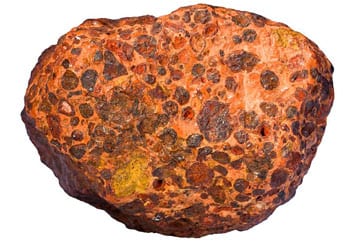Select Language:
Aluminum is the most common metal element found on Earth, totaling about 8% ny crust ny Tany. Na izany aza, aluminum as an element is reactive and therefore does not occur naturally – it needs to be refined to produce aluminum metal. Ny kilonga manomboka amin' ny viraty fanadiovam dia bauxite, Ny loharano voalohany hitadiavam-bola eto an-tany viraty. Bauxite is a sedimentary rock, and consists mostly of the aluminium minerals gibbsite (Al(Ô ry)3), boehmite (γ-Alo(Ô ry)) ary diaspore (α-Alo(Ô ry)), and is usually mixed with the two iron oxides goethite and hematite, the aluminium clay mineral kaolinite and small amounts of anatase (TiO2) and/or ilmenite (FeTio3).

Bauxite deposits dia niparitaka maneran-tany., mitranga amin' ny faritra rivo-doza na subtropical.. Although proven reserves of bauxite are expected to last for many years, ny kalitaon' ny tahiry izay mety ara-bola nojerena tamin' dia mivaralila fatratra. Ho an' ny mpandringana, who are in the business of bauxite processing to make alumina, ary farany viraty vy., Fanamby amin' ny fomba ara-bola sy environmental izany..
The process to refine metallurgical bauxite into alumina involves the following inputs:
The following outputs are generated:

The most widely used chemical process of refining bauxite into alumina, the Bayer process, involves dissolving the Al2O3 out of the bauxite rock with caustic soda (Naoh) at elevated temperature and pressure. The Al2O3 fraction of the bauxite is dissolved into solution, to later be precipitated out as alumina. Na izany aza, a high-grade bauxite contains up to 60% Al2O3, and many operating bauxite deposits are well below this, Tsindraindray toy ny 30-40% Al2O3. Because the desired product is a high purity Al2O3, ny oxides sisa tavela ao amin' ny bauxite (Fe2O3, SiO2, TiO2, Organic material) are separated from the Al2O3 and rejected as alumina refinery resides (ARR) or red mud. Amin' ny ankapobeny, ny kalitaon' ambany kokoa ny bauxite (ie lower Al2O3 content) the more red mud is generated per ton of alumina product. Ankoatry ny, even some Al2O3 bearing minerals, tsara kaolinite, produce un-desirable side reactions during the refining process and lead to an increase in red mud generation, ary koa ny fahaverezan' ny caustic lafo soda simika., sarany lehibe ova. ao amin' ny dingan' ny bauxite fanadiovam..
Ny forona mena na NY ARR dia maneho fanamby lehibe sy mandeha amin' ny viraty.. Ny fonon-tanana mena dia ahitana residual manan-danja residual ireo ambina simika avy amin' ny dingan' ny fanadiovam., ary alkaline fatratra, matetika amin' ny pH ny 10 - 13. It is generated in large volumes worldwide – according to the USGS, notombantombanana ho ny famokarana alumina amin' ny ankapobeny. 121 tapitrisa taonina 2016. This likely resulted in more than 150 Taonina ny fotaka mena azo nandritra ny vanim-potoana iray.. Na dia teo aza ny fikarohana tsy tapaka, Ny fotaka mena ankehitriny dia vitsy ny hitadiavam-bola ireo lalana maharikoriko mba hahazoana tombontsoa.. Izany dia notombantombanana ho fa ny fotaka mena dia azo avy amin' ny fomba ampiasaina maneran-tany.. Instead the red mud is pumped from the alumina refinery into storage impoundments or landfills, Aiza no tehirizina sy monitored amin' ny sarany lehibe..
Ny fahaverezan' ny caustic lafo soda (Naoh) and the generation of red mud are both related to the quality of the bauxite used in the refining process. Amin' ny ankapobeny, the lower the Al2O3 content of the bauxite, ny lehibe kokoa ny boky fotaka mena izay azo., as the non-Al2O3 phases are rejected as red mud. Ankoatry ny, the higher the kaolinite or reactive silica content of the bauxite, ny fotaka mena kokoa dia azo. The reactive silica content not only increases the volume of red mud, but also consumes caustic soda reagent and reduces the yield of Al2O3 recovered from the bauxite. Ary noho izany, there is both an economic and environmental argument to be made for improving the quality of bauxite prior to refining.
Ny dingan' ny fisarahana amin' ny fomba fisarahana dia manome bauxite producers na bauxite refiners fahafahana hanatanteraka ny dingan' ny Bayer upgrading bauxite akora mba hanatsarana ny kalitaon'. Izany fomba izany dia manana tombontsoa maro:
Ho famintinana, Ny mampiodina maina miaraka amin' ny SEparator STET dia manome fahafahana nalaina-danja ho an' ny bauxite producers sy ny refiners. Ny mampiodina ny bauxite alohan' ny hanadio dia mampihena ny simika., Ambany kokoa ny boky fotaka mena azo ary ahenao ny dingan' ny upsets.
References: